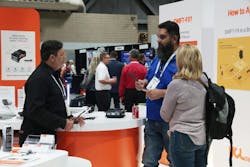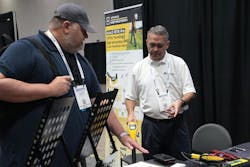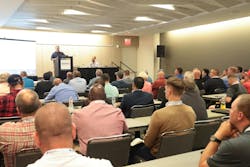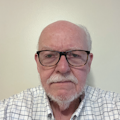Conferences and trade shows can be a great way to take a few days off, travel to an interesting place hopefully with good weather, relax and get some serious work done. Hey, it’s costing you to travel there, you have lots of work you should be doing back at home, so don’t waste time! I’ll tell you about my method for events like this and give you some assignments while you are at ISE EXPO.
I never attend an event without an agenda. My time on a show floor is spent in stages, beginning with visiting the companies and people I have targeted. I peruse the exhibitors list and schedule of presentations and note companies who are doing things I want to talk about or presentations I want to see. I read the show sponsors’ descriptions of companies’ exhibits, looking for new products or services I want to know more about.
I like to use a show floor map to circle the booths I want to visit so I can plan how to make my visits more efficient. Unless I have appointments or high priority visits, I have a system for viewing every booth of every exhibitor. If I do have appointments or want to see presentations, I create a schedule and set alarms on my phone, so I don’t forget.
With my map of the exhibits and my “must see” booths circled, I start at one corner of the show floor and head down the first aisle. I look at every exhibitor, noting what they are showing and what they are featuring—the new and exciting stuff. If it’s really interesting, I stop and chat. Sometimes I just make a comment on my map that they might be worth a second look later in the day.
Occasionally I get delayed—I see something I want to know more about, or I see someone I know, and we exchange pleasantries, reminisce and commiserate, or whatever. Then back to the schedule.
When I get to one of my targeted booths I settle down, search for someone with the technical knowledge who can answer my questions and spend some time getting the information I want. If I don’t, I move on. It’s always a big show floor and lots to see so don’t waste time.
When I attend presentations and I want to know more, I corner the speakers after the presentation and ask if we can trade business cards. You know those little rectangular paper things that some people still give away with their contact information on them. I’m never shy about contacting people later when I want to know more.
So here are your assignments for ISE EXPO:
Think about what you need to make yourself more productive. I will tell you that the first thing on your list should be more knowledge about new components and gear. Make a list then compare it to the vendors showing their wares at ISE EXPO.
Stop by every manufacturer of fiber optic cables and ask them to update you on their work in microcables and high fiber count cables. Ask about the differences between hard ribbons and flexible ribbons. What are they doing/planning with smaller diameter buffer coatings on fibers to get more fibers into smaller cables? Ask them what you need to splice these cables; do you need to invest in a new fusion splicer or just upgrade what you have? Before you leave, ask if they make all dielectric self-supporting (ADSS) cable. Learn what you can because lots of new networks are still using aerial cables and ADSS can be a viable choice on poles already overloaded with cables.
Then head to the manufacturers of fusion splicers. Have them show you the new models with all the latest automation and ask how it affects the amount of splicing you can complete in a day. Particularly look at ribbon/mass fusion splicers. You are probably going to need one soon if you don’t have one already, so it’s time to get educated.
Test equipment is next. Like everything else, test sets are getting smarter and less expensive. Productivity is the goal since testing the installed cable plant is time consuming. Simplicity is important too. Having trained techs for decades and looking at the test scores on FOA certification tests, I know that testing is the most difficult topic for most techs. Any help from the instruments is always appreciated.
Don’t pass up booths of companies in the software business. Software is important, learn all you can. Project management software can be a major contributor to higher efficiency. Documentation is a requirement of every project and software that keeps records as well as helps keep track of schedules, costs, and everything else can be really helpful, maybe essential today.
Finally, track down people who sell software and data for GIS. No OSP project should—or can—be completed today without GIS data. Often, local GIS data is available for local areas that can bring real savings and efficiency to a project.
I never attend an event without an agenda. My time on a show floor is spent in stages, beginning with visiting the companies and people I have targeted.
Check out the ISE EXPO program guide HERE and visit iseexpo.com for additional information and updates.
About the Author
Jim Hayes
Fiber Optic Expert
Jim Hayes is the Fiber Optic Expert columnist for ISE Magazine. He is a lifelong techie who has been involved in the fiber optic industry since the late 1970s. He founded one of the world's first fiber optic test equipment companies, FOTEC, which was acquired by Fluke in 2000, and he was a co-founder of the Fiber Optic Association (FOA), the international professional society of fiber optics, in 1995.
Jim is a writer and trainer and the President of FOA. He is the author of nine books on fiber optics and cabling and writes for several magazines.
Jim and his wife, Karen, who is the GM of the FOA, have traveled the world for the FOA helping set up schools to train the workers who design, build, and operate today's communications networks. The FOA offers nearly 1,000 pages of online technical materials, over 100 videos, and two dozen free self-study courses online.
For more information, email [email protected] or visit www.jimhayes.com.
To learn more about The Fiber Optic Association, visit www.thefoa.org. Follow them on Facebook: FiberOpticAssociation, LinkedIn: company/the-fiber-optic-association-inc-foa, and YouTube: user/thefoainc.



